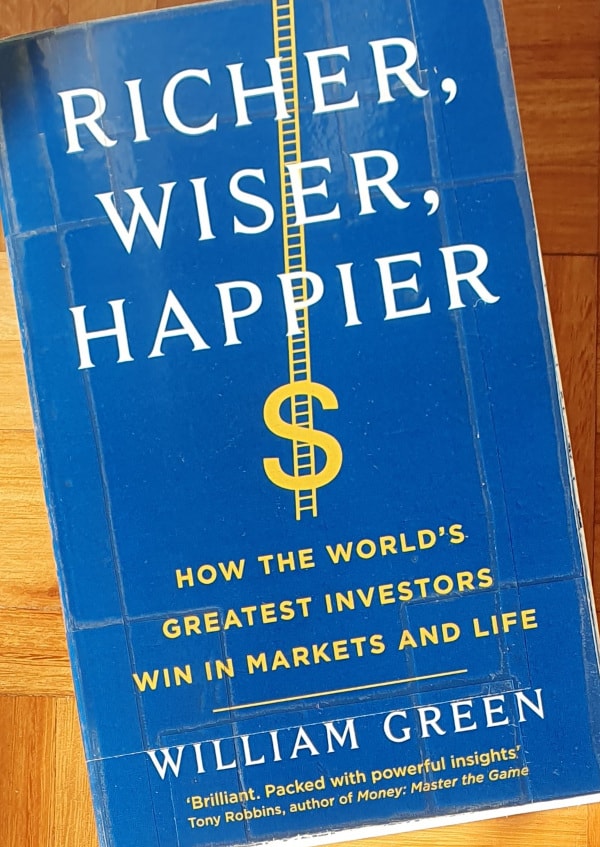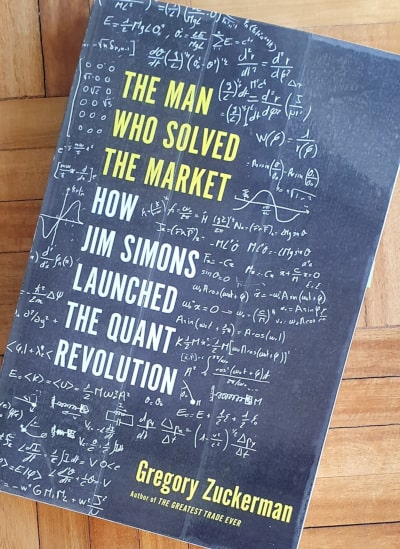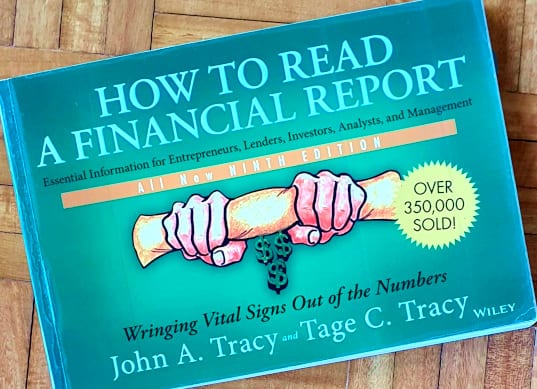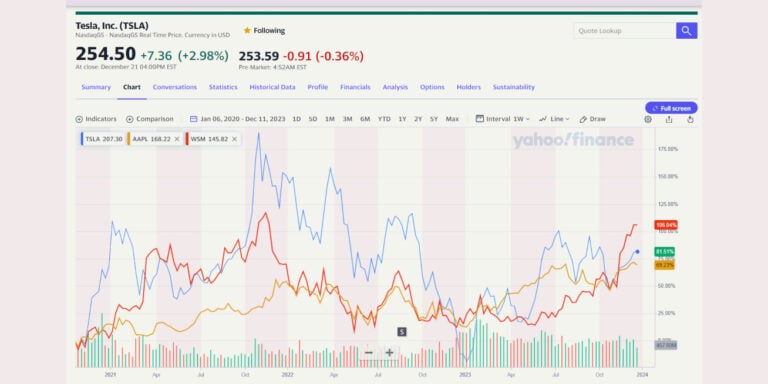Investing For Financial Success
An Investment In Knowledge Pays The Best Interest: Richer, Wiser, Happier
In thinking about investing for financial success, I’ll say it now, in case readers get no further than the first few lines here.

If you only read one book on the topic, make it “Richer, Wiser, Happier – How The World’s Greatest Investors Win In Markets And Life” by William Green (Scribner, 2021).
Prepare for a deep and eye-opening education, in addition to a great read! It has taken the serious investment space by storm.
Then, on with the intro.
Currently, most of my reserves are in ETF’s and actively managed funds. I also hold a small portfolio of stocks that I like.
I first dipped my toe into stock market investing in the early 1980’s. Since then a few things have become even clearer to me.
Probably the most important are:
- firstly, get-rich-quick stock market investment schemes are a fantasy. Fairytales for the naive
- secondly, we can forget about discovering some unique stock market investing trick that bestows a magic wand upon us in picking quality investment stocks without putting in serious work. It just won’t happen
On that point, I’ll mention an elite investing outlier called Jim Simons further down, and my other book recommendation.
We’ll be going around in circles without some kind of overall strategy or approach that we can consistently apply. It may be boring, but we need it and it will vary from person to person. I’ll outline my approach below.
Peter Lynch – Competing With Overabundance Of Intelligent People
Peter Lynch, the renowned Fidelity Magellan fund manager, a giant in the investing space and now retired, said, “the investment business is so rewarding financially and intellectually that it attracts an over-abundance of intelligent people”.
Sobering, and worth deep reflection. How might we feel we compare with those people?
If we are about average intelligence, which by default most of us are if we are honest with ourselves, we need to work very hard to merely compete, instead of underperforming the market, in our investment endeavours. Never mind outperforming the market. That’s super-hard. And the established experts advise most people to accept market returns and stick to low cost exchange traded index funds (ETF’s).
It’s good advice, far better than most may appreciate.
Stocks – Buying Part Of A Business
When we’re investing in stocks, and funds comprising stocks, we’re buying a part of businesses. And, we’re buying from current owners of those stocks who want to sell them on a stock exchange. A fund works a little differently, but similar in principle.
So for every stock buyer at that price, there is also a seller. Unless it is an initial public offering (IPO), which we won’t get into here. IPO’s should be left until we have accumulated a lot of experience in analysing stocks and businesses, doesn’t matter what our uncle, aunt, drinking buddy, taxi driver, hairdresser, or whoever, says.
Stock and fund unit prices can vary hugely, termed price volatility. Again, no matter what anyone says, a miniscule few people have any chance of predicting which way prices go over the shorter term. Long term, stock prices tend to reflect the underlying value of the business.
Many will tell us they can predict short term price swings with fancy computer programs, etc. But they can’t. It’s luck, random chance, if they get it right. The rare few, like Jim Simons, are special cases and I’ll touch on Simons later.
Company Analysis
We need to understand how a business works in the capitalist system. That is, products and services are sold at prices hopefully greater than the overall cost to produce and distribute them, resulting in a profit.
You’d be surprised how many companies are running at a loss, not making any profit. Problematic.
Stock and fund unit holders are entitled to a share of those profits, or suffer the losses, in proportion to the number of shares or units they own. We’ll talk about earnings per share (eps) and dividends another time.
We’ll need to understand the structure and relevance of three key business financial statements:
- the income statement (financial results – profit or loss – over a specific period, usually annually)
- balance sheet (financial condition, expression of how much a business is worth overall to its owners, stockholders, usually at the end of the business fiscal year)
- cash flow statement (solvency, sufficient cash flow to pay bills as they come due, again usually at the end of the business fiscal year)
Plus the basic math skills to follow and do a critical analysis of those statements.
That equips us to read Annual Reports of companies listed on stock exchanges, and fund documentation, and begin learning how to assess them as possible investment opportunities. It’s a skill, and takes time to assimilate.
Eye On The Market
Brokers are our interface with the stock market. We must choose an online broker that meets our needs. Have a look at comparison sites relevant to your particular area or country.
Interactive Brokers is highly rated, but there are many great online brokers. I use DeGiro and like them.
Some of the new digital banks, such as Revolut, have commission-free stock purchase plans. I have used Revolut to buy stocks and it works well.
The best online brokers have great knowledge and learning resources. Use them. Set a high standard. Become your own authoritative information source. Become great at it and you’ll be very popular with important people.
Bear in mind frequent trading is what online brokerages want us to do. It’s where they make their money. After all, they are businesses and need to make a profit to survive.
But, we’re doing it all wrong if we need to trade frequently.
This is exactly the opposite to what we need to be doing in making good investment choices.
If we make the right choices of stocks and funds in the first place we can hold them for the longer term.
As opposed to day trading.
Jim Simons, The Man Who Solved the Market, and Day Trading
I mentioned Jim Simons earlier. He’s a university professor and an accredited math genius.
His business is Renaissance Technologies, a private hedge fund operation, the most successful there is.
He has made a huge fortune on the basis of highly sophisticated computer and mathematical models to predict stock and commodity price movements, and ultra-rapid trading.
And today he gets only about 51% of his trades right. Enough to make him an extremely wealthy man.
He profits from people who make buy and sell judgement mistakes on the stock market. His system can predict this correctly about 51% of the time, and he pounces.
But!
RenTech has spent $ Multi-Millions on supercomputers. They have a research database that grows by more than 40 terabytes a day, data on factors that might influence and help predict stock and commodity price movements.
Simons has also surrounded himself with more than 300 elite researchers. These are cream of the crop computer scientists and mathematicians, including 90 PhD’s.
They spend their days looking at all this data to find ways to predict stock price movements.
They are highly motivated, and he pays them extremely well.
Many of them are now millionaires, and some billionaires.
And it took him and his army of intellectuals from 1982 to about 2002 to get his system to work consistently. Twelve years in, they were still failing at trading.
It took about 20 years of hard work!
They were making between 150,000 and 200,000 trades a day back in 2002.
So I’m sorry. But anyone who thinks a snazzy day trading app on their laptop, and paying a few hundred or a few thousand dollars for a day trading course is the sure route to a fortune, just doesn’t have a grip on reality! They are almost certain to join the vast majority of day traders that lose money. Though there might be the rare fluke that proves the rule.

Read the book, “The Man Who Solved The Market – How Jim Simons Launched The Quant Revolution”, by Gregory Zuckerman.
It’s all there and it’s a great read too.
So the quant approach is not a realistic option for normal mortals. We need to set our sights on more down-to-earth possibilities.
Investment Process – My Summary Steps
Investing in stocks is such an expansive subject that this section will just headline the broad steps I use. So outlining those:
- decide on an allocation between ETF’s and stocks, depending on desired risk profile
- set up a stock screener, such as the free one in Yahoo Finance, based on exchange location and sector, business market capitalisation category, profitability, earnings and price attractiveness, and debt levels
- extract and tabulate (Excel) the current and available historic data points (typically 3 years)
- calculate financial ratios for performance measures of choice from data points. More articles about this later
- allocate a weighting to each parameter, sort and filter to a short preferred list for deeper analysis
- analyse annual reports, rank management, competitive advantage, and future prospects
- read relevant news articles in the serious press, such as Wall Street Journal
- from there we can make informed comparative decisions
- if prices are too high on stocks of choice, consider waiting until prices move to more attractive levels to provide a better margin of safety
There is a great deal to talk about in each step. More articles to follow.
Disclaimer
This article is for informational purposes only, it should not be considered investment or financial advice. Investments put your capital at risk. Investments can go down as well as up. Past performance is not a reliable guide of future results. Consult an investment or financial professional before making any major financial decisions.







